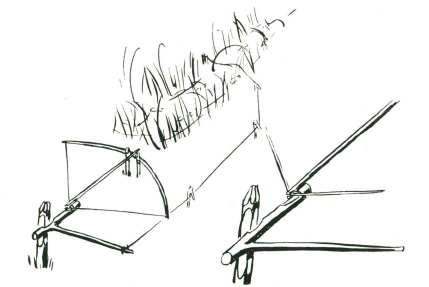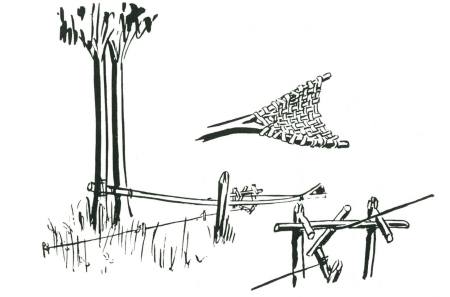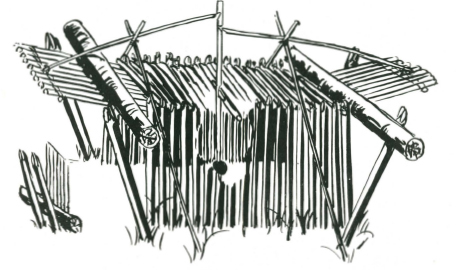After setting this trap it should be given a test drop and, if satisfactory, reset only after placing warning notices several yards either side telling people to pass around the area, and not under any consideration to pass along the track. Failure to provide these notices might easily lead a careless person into gaol for manslaughter.
Remember this trap is a potential man-killer.
BOW TRAP FOR GUARDING A PATH

This is an extremely dangerous trap, and a certain man-killer if the bow is strong and the trap properly set. It should not be used except in cases of emergency.

A bow of considerable strength is made, and lashed to two stakes driven securely into the ground. The two stakes are set an inch or so apart. At right angles to the bow, and at the position where the bow string will come when the bow is drawn, a third stake is driven into the ground. The horizontal angle between the lower end of this peg and the place where the bow is lashed to the twin pegs should be such that the arrow will be given correct elevation to catch the man or animal at a vulnerable height when the trip cord is touched. The site should be at the bend of a trail or path.
Release can be effected by a hooked stick which has a square nick cut on the outside edge of one side, and at right angles to this cut a reversed nick is cut to take the bow string. The rear peg is squared at its rear and on one side to form a right angle. The squared cut of the release stick engages the squared face of the stake, and the thong is hooked over the undercut nick, so that the bow is held drawn back to the rear peg. The arrow notch is in the thong. Release is effected by tying the release cord to the other end of the hooked stick and leading the release cord through the grass or bush to a position at the edge of the path. Guiding of the cord is effected by means of inverted hooked sticks. At the path the release cord is tied to convenient growing material such as a wisp of grass, a ground vine, or even a casual stick.
An alternative release is effected by deeply nicking with a square face the underside of the arrow. Into this nick a chisel edge release toggle stick is engaged. The release stick passes in the rear of a short cross bar so that the forward-pull of the bow pulls the lower end of the release stick to the rear. This lower end is pressed against a trigger stick which is pushed against an anchor peg. To this trigger stick the trip cord is tied and from here it is led through the bush to the path, and set as a trip cord across the trail in the same manner as the hooked stick release.
A WORD OF WARNING . . . remember that this trap is a man-killer. Never ever leave it set and unguarded unless to defend yourself. Place warning signs on the path.
THROWER

There may be occasions when it is desired to create a diversion on one side of a path in order to frighten animals or people moving along the path away from it and into an ambush. For this purpose a thrower can be set up at a convenient distance from the path so that when a trip cord is touched the thrower will hurl a stone or other missile onto the path, and so drive the animal off the path and towards the hunter.
A forked springy sapling is lashed between two trees as for the stabber. The end of the sapling is forked, and in the forked end a shallow pouch is woven between the forked sticks. These forked sticks should be at an angle of about 45 degrees from the horizontal towards the path. The sapling is bent back and down and secured as for the stabber, and about four feet short of the place where the head came when it was at rest a very stout stake is driven into the ground to act as a 'stop' to the forward thrust. The sapling must be lashed fairly high up the two trees and bent downwards to the securing release, so that when it is tripped the movement is upwards. When the sapling is released and swings upwards it carries the stone in the pouch, and coming suddenly to the stop the stone is thrown from the forks forward to the path.
PIG STABBER
NOTE.—This is a very dangerous trap to leave set where it might injure anyone walking along the path. Warning notices should be set on

A site is selected where two trees grow close together near the path the animal uses. A very springy sapling is cut, and lashed between the two trees so that when unbent it reaches to the centre of the track. To the end of this sapling a sharp dagger-like knife, or failing that, a pointed spear of hardwood is lashed. If wood is used, make sure that it is straight grained, and harden the end by scorching over fire. Sharpen to a good point.
The sapling is bent back as far as your strength will permit and note where the bent back of the sapling comes to above the ground. A few feet back from this point set the sticks for the release given in the snare ‘Toggle and Bait Stick’ (page 236). To the bait stick of this release tie the trip cord, and run this along the ground to the position at which the bent sapling came when the head was straight over the path. The trip here should be very light and raised a few inches above the ground. The animal passing along the trap in either direction releases the trip, and the sapling is released with the spear.
Caution. Remember that this is a very dangerous trap and if used, warning notices must be placed either side.
BOX TRAP TO CATCH ANIMALS ALIVE
DOUBLE-ENDED PEN WITH SELF-LOCKING DOORS

A strong pen of the size required is constructed with both ends left open. The pen is completely roofed over, and in the centre, one of the cross sticks across the roof is squared on one side and on its under surface. The cross pieces at the extreme ends are secured extra strongly to take two drop doors. A couple of inches beyond the line of the side walls, and about three inches from the end uprights very strong stakes are driven into the ground at an angle leaning away from the line of the pen. The two doors are made and hinged with loops of rope or strong vine to the end crossbars, across either end of the pen. On the outside, two support sticks are crossed about seven to ten inches above the roof of the pen. The release sticks are sharpened at one end to a chisel edge, and the bait stick is cut with a squared step about eighteen inches below its top (the square face at the lower end). Ten to twelve inches above this and parallel to the first cut, two square-nicked cuts are made with the squared face on the top side of the cut. The trap is set by putting the bait stick between the crossbars and engaging the squared cut of the bait stick with the squared face of the cross bar. The chisel end of one of the release sticks is placed in one of the top nicks of the bait stick, and the other end between two of the crossbars of the door. The release stick sits on the support sticks as a fulcrum. This is repeated at the other door. Both doors are now raised, and any disturbance of the bait stick will release the support sticks and the doors will drop. The locking device is effected by cutting two heavy poles about eight to ten inches longer than the trap is wide. These are laid across the top end of either door. When the doors start to drop the logs roll down the falling doors, and jam against the outward leaning stakes, thus wedging the doors tight.
PORTABLE BOX TRAP
BOX TRAP TO CATCH ANIMALS ALIVE EXTERNAL RELEASE